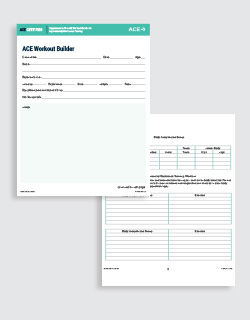The ACE Workout Builder for High-intensity Resistance Training

Everyone wants to make the most of their time in the gym, right? From mainstays like circuit training to social media trends like the 12-3-30 workout, people are always looking for ways to get the results they’re seeking as quickly as possible.
The most popular time-saving workout is probably high-intensity interval training (HIIT), which is a feature of many people’s weekly workout programs, not to mention countless group fitness class schedules. The proven benefits of HIIT include improved cardiovascular health, increased metabolic rate, improved insulin sensitivity and enhanced fat loss—all in a time-efficient workout. ACE-sponsored research has demonstrated that adding HIIT to a more traditional cardiorespiratory training program can elicit significantly greater improvements to health and fitness than a traditional program alone.
But, what about resistance training? Is there a way to mirror the template, and more importantly the proven outcomes, of HIIT in the form of a muscular-training program? Introducing HIIT’s lesser-known cousin HIRT—high-intensity resistance training.
There are a number of HIRT protocols, but all involve performing muscular-training exercises with maximal effort and minimal recovery time between sets. Lift as much as you can for a handful of repetitions or a designated amount of time, take a quick break, and move on to the next exercise.
ACE Evaluates the Effectiveness of HIRT
Another piece of ACE-sponsored research compared the effectiveness of HIRT to a traditional moderate-intensity muscular training program. In this study, the HIRT workout consisted of one set of five repetitions of 10 exercises at 100% of each participant’s five-repetition maximum (5-RM) (i.e., the most weight a person can lift for exactly five repetitions). The frequency progressed from two to three workouts per week over the course of the six-week study.
The researchers looked at muscular fitness and cardiometabolic outcomes, as well as the timing of training adaptations. What they found was that HIRT was equally effective as (and it some instances more effective than) the traditional program at improving cardiometabolic health and muscular fitness, and that HIRT yielded favorable adaptions in less than half the time (20-minute workouts vs. 45-minute workouts). There was also preliminary evidence that HIRT improved muscular fitness more quickly than the traditional workout. These rapid results can serve as an important source of motivation for clients just starting with an exercise program.
Safety Considerations
HIRT hits the mark in terms of effectiveness and time-efficiency, but there is a third consideration that all exercise professionals should keep at the forefront of their minds when designing an exercise program: safety. Proper lifting technique and breathing patterns are essential when doing heavy lifts, such as the 5-RM lifts performed in the research cited above and the sample workout provided below.
It’s also essential that the outcomes of HIRT align with your client’s goals. For example, if your client is interested in building muscular endurance, the small number of repetitions performed in a HIRT protocol may not be adequate to help them reach that goal.
Recovery is another important safety consideration, as lifting heavier loads or training to failure may increase recovery demands. Ample recovery time between HIRT workouts is essential to prevent overtraining and promote muscle growth. HIRT sessions targeting the same muscle groups should be performed a maximum of three days per week. The idea is to recover enough between sessions to return to your baseline level of performance.
In addition, it is important to take into account not only a client’s training goals, but also their health history when designing an exercise program. When programmed appropriately, HIRT can be an effective method for helping clients achieve their muscular training goals.
The Workout
While HIRT workouts can be organized by function, lower-body/upper-body splits or even as a form of circuit training, the workout below was created using the Body Area/Muscle Group section of the ACE Workout Builder (see the link above for a downloadable PDF). After working with the client to fill in page 1 of that document, the next step is to create an exercise list that aligns with the client’s abilities and goals. Use the ACE Exercise Library to find exercises based on equipment availability and difficultly level. The following is a sample list of exercises:
|
Upper Body |
Torso |
Lower Body |
||||
|
Chest |
Back |
Shoulders |
Arms |
Torso |
Hips |
Legs |
The sample workout below can be performed two to three days per week. Share the following instructions with your client:
- Complete one set of each exercise in the order listed and be sure to transition between exercises with little to no rest.
- Perform each exercise for five repetitions. The key is to use a weight that is heavy enough so you can complete each exercise a maximum of five times. If you can lift the weight more than five times, select a heavier weight. If you reach fatigue before performing the five repetitions, decrease the weight.
- You can progress to two to three sets over time. If performing multiple sets of each exercise, complete the full workout before starting back at the top to complete another round. In other words, do not complete multiple sets of each exercise consecutively before moving to the next one; instead, complete the full workout, then start back at the beginning.
|
Body Area/Muscle Group |
Exercise |
|
Chest |
|
|
Hips |
|
|
Back |
|
|
Hips/back |
|
|
Shoulders |
|
|
Hips/legs |
|
|
Arms |
|
|
Legs |
|
|
Arms |
|
|
Torso |
Note that most of the exercises in this sample workout are performed using dumbbells. (The calf raise requires a machine; the pull-over crunch, while shown here with a kettlebell, can also be performed with a dumbbell.) Choosing exercises using the same equipment allows for easier transitions and reduces recovery time between exercises and makes for a smoother workout.
Final Thoughts
HIRT, like HIIT, offers clients the opportunity to achieve results quickly and safely, provided that the exercise program is personalized to each client’s fitness and ability levels and aligned with their fitness goals. The first key to success is to choose the right exercises, being mindful of equipment availability and the space in which your client will be exercising. For example, if your client prefers using weight machines rather than free weights, design a full-body program using the machines available at the fitness facility.
The second key to success is the identification of the appropriate resistance for each exercise, which will take some trial and error during the initial HIRT session. Remember, the goal is to find the client’s 5-RM for each exercise, meaning that the client can perform five repetitions with proper form, but not a sixth repetition. Once a client is able to move beyond five repetitions, it’s time to increase the weight.
Some clients may think the promise of HIRT is too good to be true—similar or better results in less than half the workout time. If that’s the case, show them the evidence at the link above and have them integrate HIRT into their weekly routines. The results will speak for themselves.
Expand Your Knowledge
Yoga Fundamentals: Integrating Yoga Into Client Programs
If you want to enhance your skills and offer clients a structured, practical approach to incorporating yoga elements into their workouts, this course is for you. By focusing on foundational poses, mobility and balance, you’ll be equipped to help clients improve flexibility, strength, and recovery—all without sacrificing the intensity of their fitness goals. This course breaks down yoga into digestible, movement-focused components, offering insight into sequencing, regressions, and progressions for diverse client needs. Learn to use tools and props effectively, ensuring accessibility for clients of all ages and abilities. Whether you’re easing beginners into basic stretches or adding dynamic mobility flows for seasoned athletes, this course empowers you to use yoga as a versatile tool in your fitness arsenal.
Programming for Strength Gains
Knowing how to help your clients avoid plateaus and make consistent strength gains will help you keep their internal fire burning. The science of strength training, though, is constantly evolving. New studies, new approaches and new techniques seem to emerge every day. It can be tough to keep up with the latest changes when you’re focused on changing your clients' lives. The Programming for Strength Gains course teaches you how to combine emerging strength training science with your existing program—and learn how to take your clients’ fitness to the next level.
More Articles
- Certified™: April 2025
The ACE Do It Better Series: The Barbell Clean and Jerk
Health and Fitness Expert
- Certified™: April 2025
To Adjust or Not to Adjust? A Guide to Hands-on Yoga Assists
Health and Fitness Expert
- Certified™: April 2025
Repetition Tempo and Muscular Development: What’s the Connection?
Contributor









